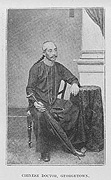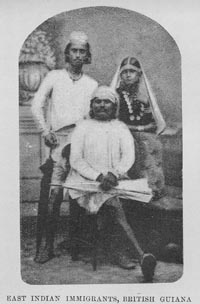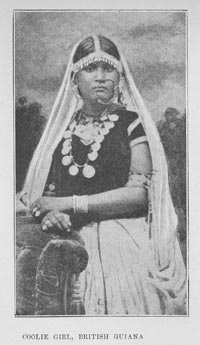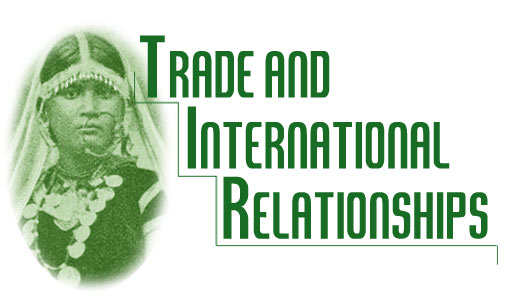
Throughout the history of the British West Indies, no other era was so fraught with
change as post-emancipation decades.
Within a period of a few years, the entire economic and social
system of these colonies was turned upside down.
More importantly, this turmoil seems to have been self-imposed,
at least on the part of Great Britain.
Britain was fighting a costly battle against
the illegal slave trade and failing miserably. Also, after  emancipation,
the planters refused to meet the working conditions demanded by the
former slaves. This led to a mass abandonment of field labor,
which caused plantation production throughout the colonies to plummet.
In response, Britain began an unnecessarily costly system
of importing indentured servants. By
diverting money towards fighting the slave trade and importing indentured
servants rather than appeasing the former slaves, Britain greatly hindered the economic development
of the colonies, removing the planters’ incentive for change and adjustment. emancipation,
the planters refused to meet the working conditions demanded by the
former slaves. This led to a mass abandonment of field labor,
which caused plantation production throughout the colonies to plummet.
In response, Britain began an unnecessarily costly system
of importing indentured servants. By
diverting money towards fighting the slave trade and importing indentured
servants rather than appeasing the former slaves, Britain greatly hindered the economic development
of the colonies, removing the planters’ incentive for change and adjustment.
The
slave trade continued after emancipation for one reason, its sheer profitability.
The traders could lose the majority of their human contraband
and still remain profitable. If one in four vessels made a successful voyage
to the West
Indies
then the dealer was repaid for his expenses.
[1]
In individual terms, this means that the dealer
only had to transport 350 slaves successfully in order to cover the
loss of 2475.
[2]
Given this immense profitability, it is no wonder
that the trade continued so prodigiously after emancipation. The select committee on the slave trade in the
British House of Commons estimated that in the years following abolition,
82,000 slaves left the coasts of Africa each year with the vast majority of them landing successfully
in the Caribbean.
[3]
In
fact, the lucrative nature of the slave trade made it impossible to
suppress. As Lord John Russell stated in a letter to the
Lord of the Treasury, “The whole British navy would not be sufficient
to stop illegal slave trade because of the profit they derive.” He goes on to say that “From 1845 on the strength
and efficiency of the British Preventive Squadron has been raised to
the highest point ever and supported by France and the United States,
but still only [saved] four percent of slaves carried off Africa in
those years.”
[4]
Besides the overwhelming failure of these
attempts to end the slave trade, the preventive measures had an extraordinary
cost. Lord Russell estimated
that the annual cost of suppression was at least 650,000 pounds and
possibly as high as 1,000,000 pounds.
The latter amount was supposedly equal to one fifth of all revenue
from the British income tax at the time.
[5]
Given that emancipation of slavery itself was
estimated to have cost Britain 20,000,000 pounds, the huge cost
of suppression was a terrible burden on the British economy.
[6]
Besides the costs, the futility of this exercise
was realized by the British government itself; one official states,
“England took fifty years to mediate and resolve
on an act of justice to Africa. Yet we expect other
nations, implicated like ourselves, to come at once to the conclusions
we had formed after such fierce and ling struggles between selfishness
and humanity.”
[7]
Still-growing Cuba, in particular, demanded more slaves
in order to keep its sugar economy running. Faced with such economic and moral impetuses
working against them, the British government had little hope of dismantling
the slave trade no matter what efforts were taken.
The irony of Britain’s attempt to suppress the importation
of slaves to the other colonies is that the British colonies themselves
sought an outside source of labor in order to keep their plantation
system alive. Certain islands
such as Trinidad could never under slavery or freedom
produce a sufficient Creole labor force to cultivate the land.
[8]
Similarly, at the time of emancipation Jamaica had a population of 350,000 while
it could support 4,000,000.
[9]
The years after emancipation saw an exodus of
former slaves from field labor to sustenance farming. As one planter states, “The idea that the Negro
would become a grateful and cheerful free laborer on the soil which
had been watered by his tears in slavery, proved fallacious.”
[10]
The planters’ claim that this migration was
a “natural consequence” of emancipation was partially correct,
however, they failed to see that it was in a large part due to their
treatment of the former slaves.
[11]
Although they were free, the planters expected
the Creoles to work in much the same way as they did under slavery and
resorted to the same punishments if they did not do so. In fact, the special magistrates of Antigua claimed that, “they [had] more trouble
with petty overseers and managers than with the entire black population.”
[12]
Given the low wages the Creoles received and
the harsh treatment of the overseers, it is no wonder that ex-slaves
abandoned field labor.
The lack of labor and the Creoles’ desire for economic independence
nearly destroyed the plantation economy. Planters could not find enough laborers to the
work the land and consequently had to cut production. This resulted in a loss of profit that forced
them to sell sections of land at inexpensive prices to the Creoles who
would then farm for sustenance rather than profit.
In this way, the planters were continually diminishing the available
labor force as well as the amount of land that could be put into production.
[13]
Britain’s Caribbean colonies could not sustain themselves
under these conditions. The only
hope apparent to the British was the importation of laborers. However, as one contemporary author noted, “Importing
slaves from other colonies [would] only drain their [i.e. that of the
formerly slaveowning colonies] capital.”
[14]
While in islands such as Trinidad there were several hundred voluntary
immigrants from Africa, the task of  persuading
a sufficient amount of Africans to freely leave their homeland with
the same people who carried off their brothers in chains must have seemed
a bit daunting.
[15]
In addition, the importation of Africans, whether
voluntarily or not, would have seemed too similar to the trade that
Britain was fighting so hard to suppress. Therefore, the only suitable solution seemed
to be importation from a source other than Africa.
The British conveniently found this source in their Indian empire. By bringing indentured servants from their own
possessions, the British were able to justify this relocation as “merely
moving British subjects from one portion of the empire to another.”
[16]
Besides strengthening the labor force, the British
hoped that the importation of servants would strengthen trade, and would
also help to stop the slave trade. persuading
a sufficient amount of Africans to freely leave their homeland with
the same people who carried off their brothers in chains must have seemed
a bit daunting.
[15]
In addition, the importation of Africans, whether
voluntarily or not, would have seemed too similar to the trade that
Britain was fighting so hard to suppress. Therefore, the only suitable solution seemed
to be importation from a source other than Africa.
The British conveniently found this source in their Indian empire. By bringing indentured servants from their own
possessions, the British were able to justify this relocation as “merely
moving British subjects from one portion of the empire to another.”
[16]
Besides strengthening the labor force, the British
hoped that the importation of servants would strengthen trade, and would
also help to stop the slave trade.
While the system of importing indentured servants would eventually
prove profitable, the initial expense was an additional burden on Britain’s economy. The first Asian immigrants arrived in the Caribbean in 1846 with what is described as
an “enormous cost” in bringing them over.
16,000 immigrants from British India, known as “Coolies,” were originally brought to Trinidad  from
Madras and Calcutta.
[17]
The colonies paid the passage for the Coolies
through a duty on rum, plus a special cost to the employer of about
25 pounds per hogshead of sugar.
[18]
Sewell states, “The chief feature in Trinidad immigration is its entire management
[under] the responsibility, not merely of the colony, but of the government
and people of Great Britain.
Private speculation has no directing voice in the scheme.”
[19]
The extent of the government’s control in this
matter was obviously meant to assure that this new system would not
come to resemble the illegal slave trade.
The government allowed no more than 360 Coolies to be carried
on what the author refers to as a “first class ship.”
While it is doubtful that any indentured servants have ever been
carried on first class ships, the average death rate of three quarters
to one percent during these voyages seems to attest to at least some
care was taken of both the ships and their passengers.
[20] from
Madras and Calcutta.
[17]
The colonies paid the passage for the Coolies
through a duty on rum, plus a special cost to the employer of about
25 pounds per hogshead of sugar.
[18]
Sewell states, “The chief feature in Trinidad immigration is its entire management
[under] the responsibility, not merely of the colony, but of the government
and people of Great Britain.
Private speculation has no directing voice in the scheme.”
[19]
The extent of the government’s control in this
matter was obviously meant to assure that this new system would not
come to resemble the illegal slave trade.
The government allowed no more than 360 Coolies to be carried
on what the author refers to as a “first class ship.”
While it is doubtful that any indentured servants have ever been
carried on first class ships, the average death rate of three quarters
to one percent during these voyages seems to attest to at least some
care was taken of both the ships and their passengers.
[20]
Britain’s attempts to contrast the
conditions of indentured servitude with those of slavery were also evident in
the treatment of the Coolies. Under
indenture the Coolie had to work nine hours a day except for Sundays, holidays,
and when sick. Additionally, the
government assigned a superintendent to serve as “protector” for the
Coolies. He made sure that they were not
separated from their families and could end their indenture if their masters
mistreated them.[21] What is ironic about the treatment of the
Coolie is that the colonists were unwilling to extend the same benefits to the
Creoles already living there. The
planters themselves admitted that they preferred the work of the Creole to that
of the Coolie, yet they were unwilling to give them the benefits they demanded
because of their own pride.[22] Before immigration had begun, the planters
raised the question of whether it was better and cheaper to accept the terms of
the Creole than to suffer “the heavy outlay which a forced system of
immigration imperatively required.” [23] Despite the cost, the planters
overwhelmingly chose the latter. In 1852
on the island of Trinidad there were 80 applications made to
the office responsible for Coolie immigration for an “aggregate” of 2,000
Coolies, averaging about 25 for each estate applying. By 1857 the corresponding demand rose to
7,000 from 179 properties, averaging about 40 to each applicant. This was accompanied by a voluntary offer on
the part of the employers to double the fees payable to government on each
contract.[24] Therefore, the British were willing to pay
exorbitant amounts of money to import and care for indentured servants rather
than to treat former slaves with simple justice. .
The planters’ claim about the good treatment of the
Coolies was questionable. They stated
that the Coolie could buy himself out of indenture after three years by paying
1.20 pounds for every month left in his term.
Sewell noted that on average only five percent did so and claims that
this is “proof of how well they are treated.” [25] However, he failed to note that by purchasing
the rest of his indenture, the Coolie would have to forfeit over half of his
wages for the three years he had worked.
Thus the Coolie was either bound to his ten-year term or forced to work
three years for virtually nothing.
In some ways this new system of importation eventually
proved to be mutually beneficial to some of the British West Indies and British India as well. The Coolies were given free passage back to India after the period of their
indenture was up most of them returned with large quantities of money. The average ship returning to India was estimated to carry between
40,000 and 50,000 pounds on board.[26] For the Caribbean colonies, the benefits of Coolie
immigration resulted not only in improved trade with British India but with other nations as
well. On the island of Trinidad exports for the year 1842, before
the introduction of a foreign labor force, were 20,506 hogsheads of sugar. By 1858 exports had risen to 37,000
hogsheads. Similarly, before
emancipation the highest exportation of cacao was 3,200,000 lbs while by 1860
this number had reached 5,200,000 lbs.[27]
While these increases in production are significant, it is
important to note that they were only achieved nearly twenty years after
emancipation and after nearly fifteen years of Coolie importation. These numbers could have been achieved far earlier
if the planters had met the conditions of the Creoles rather than devoting
unnecessary amounts of money to the importation and care of the Coolies. The costs of indentured servitude, along with those of
the futile battle against the illegal slave trade would have easily satisfied
the Creoles demands and left a tremendous surplus. Additionally by meeting the Creoles’ demands
the plantations would have returned to profitability much sooner and therefore
would have produced more revenue and trade.
Therefore, the inability of British to submit to the will of their
former slaves set back the colonial economy by a number of years.
Endnotes
[1]
Barrette, The Speeches of Mr.
Barrette and of Mr. Burge at a General Meeting of Planters, Merchants,
and Others Interested in the West-India Colonies; Assembled at the
Thatched-House Tavern on the 18th of May, 1833, (London,
1833,) 8.
[8] W.M.G. Sewell, The
Ordeal of Free Labour in the British West Indies, (London, 1863), 129-130.
[12]
James Thome and Horace Kimbal,
Emancipation in the West Indies: A Six-Months’
Tour of Antigua, Barbados, and Jamaica in the Year 1837, (New York, 1838) 65.
[14] William H. Burnley, Observations on the Present Conditions of the Island of Trinidad and the
Actual State of the Experiment of Negro Emancipation, (London, 1842), 52.
[27] Sewell, 139.
Bibliography
Barrette. The Speeches of Mr. Barrette
and of Mr. Burge at a General Meeting of Planters, Merchants,
and Others Interested in the West-India Colonies; Assembled at the Thatched-House Tavern on the 18th
of May, 1833. London: A.J. Valpy, 1833. Pgs 4-14.
Burnley, William Hardin. Observations on the
Present Conditions of the Island of Trinidad and the
Actual State of the Experiment of Negro Emancipation.
London: Longman,
Brown, Green, and Longmans, 1842. Pg 52-54.
Sewell, W.M.G. The Ordeal of Free Labor in the British West
Indies. New York: Harper
and Brothers, 1861. Pgs 118-153.
Thome, James J. and Kimbal,
Horace. Emancipation
in the West Indies.
A Six
Months Tour of Antigua, Barbados and Jamaica in the Year 1837.
New York: American
Anti-Slavery Society, 1838. Pg 65.
|
